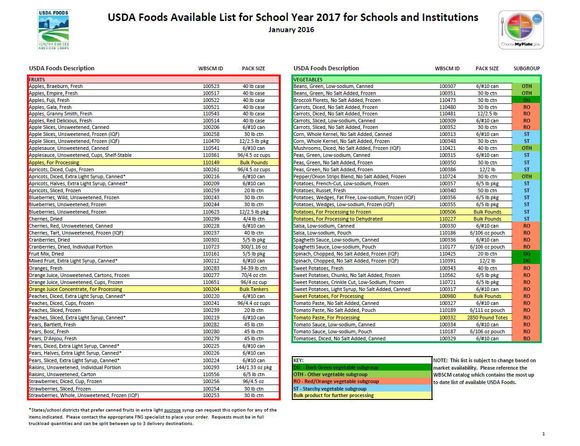
We are pleased to announce that the 2015
Dietary Guidelines for Americans (DGA) have been released! The DGAs are the Nation’s go-to source for
nutrition advice. Published every 5 years for public health professionals, each
edition of the Dietary Guidelines reflects the current body of nutrition
science. These recommendations help Americans make healthy food and beverage
choices and serve as the foundation for vital nutrition policies and programs
across the United States. The improvements to USDA Foods products over
the last 10 years put them in a good position to support the 2015 DGAs, but USDA
will be reviewing the products to make any necessary changes
to ensure they align with the current DGAs. To help program participants translate the Dietary Guidelines messages
into their own lives, we encourage you to use the excellent nutrition education
materials that are available through MyPlate.
The Agricultural Marketing Service (AMS) Commodity Procurement Staff would like to express its appreciation for the contractors and suppliers, industry
organizations, distributing agency partners, recipient agency representatives, and all the USDA
Foods supporters and stakeholders whose dedication and involvement help make
AMS Food Purchasing activities a success.
The Fiscal Year (FY) 2015 "Annual Purchase Summary" report is now available for your exploration on the AMS Food Purchasing Reports website. This report, and those from previous years, provides an overview of awards, including contractors, products, volumes, and dollar amounts. Also, check out the "Purchases by Commodity" report for a running total of year-to-date purchases by agricultural
commodity, as well as prior year totals; this data is updated frequently.
Your involvement in the USDA Foods program helps provide
billions of pounds of American-produced foods to schools, food banks, community
organizations, and families every year. Without you, it wouldn't be
possible. So, thank you! Together We’re Making a Difference: American
Agriculture for the American People.
The School Year (SY) 2016-2017 USDA Foods Available List is now available for States and school districts to begin to make ordering decisions for the upcoming school year. The list includes 217 product options for programs participating in the National School Lunch Program (NSLP), the Child and Adult Care Food Program (CACFP), and the Summer Food Service Program (SFSP). To stay current with ordering patterns and school food trends, USDA discontinued 16 items and added 18 new options, including products such as a frozen pepper/onion blend, individual portion dried cranberries, pulled pork, and individual portion peanut butter cups.

Have you ever had an idea for a product you would like to see USDA Foods offer? If so, we want to hear from you! Each year, USDA receives feedback from a number of States, school districts, food banks, and food vendors with ideas about products they would like to see offered through USDA Foods programs. When ideas are submitted, USDA reviews and compares them to the criteria in our requirements document for new products, called How to Get Your Product Considered. As stated in the document, it is important for USDA to ensure a few factors before moving forward with further product exploration, including: confirmation of 100% domestic origin, that the item has been successfully used by the recipient population, that more than one supplier can produce the product, and that there is enough production capacity to meet the nationwide needs of USDA Foods programs. Anyone who has an idea for a new product that meets these requirements should send us an email at USDAFoods@fns.usda.gov. We look forward to hearing your ideas for ways USDA Foods can better meet the needs of our program recipients!
Happy Ordering Season to the States and school districts
participating in the National School Lunch Program! As you prepare to place orders for the
upcoming school year, we want to remind States about another way to split trucks
to help you get the right products in the right quantities and at the right time. Many of you may split trucks with a
neighboring State, but did you know that you can also split with another
program receiving USDA Foods in your own State (e.g. CACFP, TEFAP, or CSFP)? Just enter the quantities needed under the
appropriate program (make sure the total orders add up to a full truck) and
provide a correlation number to link the orders in WBSCM. CACFP and NSLP have the same list of available
products, and this year, there are 13 products available for Child Nutrition Programs
that align with the items offered through TEFAP and 4 that align with CSFP, such
as dry beans, brown rice, frozen fruit, individual portion items, and turkey
roast. Remember, trucks can only be split between up
to 3 different delivery destinations. If
your State Distributing Agency has questions or needs more information about how to split trucks between
programs, contact an FNS ordering specialist or your Regional Office for
assistance.
"USDA Foods Processing from Soup to Nuts" Webinar Series
Our spring webinar series for school programs is underway! If you missed our February events, check out our Food Distribution playlist where the recordings will be posted in the near future. Our next sessions will be Order Management and Monitoring, Parts 1 and 2, on March 10 and 31. Register here for the March 10 webinar geared toward processors,
distributors, State Distributing Agencies, State warehouses, and other
receiving organizations.
USDA Foods Complaints Webinars now available on YouTube!
The recordings from our very popular winter webinar series are now available on the USDA Food and Nutrition Service YouTube channel! View "Demystifying the USDA Foods Complaint Process" and "Applying the USDA Foods Complaint Process" to learn more about how the complaint process works and how you can better handle and report any issues you have with your USDA Foods products.
Maryland State Department of Education USDA Foods Processing Workshop
On December 2, 2015, the Maryland State Department of Education conducted its 8th annual USDA Foods Processing Workshop in Clarksville, Maryland. The purpose of this workshop was to provide Maryland School Food Authorities (SFAs) with program updates and an opportunity to see and sample all of the foods that are approved for USDA Foods Processing in Maryland. State Food Distribution officials as well as FNS Food Distribution staff were presenters at this annual workshop. More than forty food manufacturers participating in the National Processing Agreement Program provided product samples to attendees after the workshop.
 Julie Skolmowski provides USDA Foods updates during the processing show general session.
 Manufacturers provided product samples to attendees.

What food is high in
protein, has virtually no fat, and has more fiber than most whole grain foods?
The answer is beans!
Beans
are excellent sources of protein and dietary fiber. In addition, they
provide other important nutrients, such as iron, zinc, potassium, and folate, which can help keep the body healthy and prevent disease.
Beans
are a versatile food with a similar nutrient profile to other protein
sources, as well as some vegetables. This means that they can be classified as either a protein or a
vegetable in the MyPlate meal patterns, depending on the other foods
served.
AMS
has approved a bonus purchase for great northern beans and pinto beans that
will be sent to The Emergency Food Assistance Program (TEFAP) sites in the coming months. These beans can be used in salads, soups,
casseroles, chili, or prepared as a side dish. To help recipients successfully use beans at home, please refer to our
USDA Foods Fact Sheets for cooking instructions and recipe ideas, such as Full of Beans Hot Dish and Bean Filling for Tacos or Burritos.
Check out the What's Cooking? USDA Mixing Bowl recipe database for additional culinary inspiration such as the Purple Power Bean Wrap, Pasta with Greens, Beans, and Chicken, and Harvest Stew utilizing great northern beans or Beef and Bean Chile Verde, Caribbean Pink Beans, and Mac and Beans Medley incorporating pinto beans. Or even try Italian Bean Soup or the Vegetable Chili Boat, both featuring a trio of beans!
|
Oklahoma Local Education Agency (LEA) and Tribe Work Together for FDPIR
Direct Certification (DC) Success
Adapted from the "Match to Meal" newsletter, Fall 2015, Issue 8, published by the USDA Child Nutrition Programs Operational Support Branch
Direct certification is a school meals concept, so students don't have to be "certified" twice with family income data for different USDA nutrition assistance programs, such as the Supplemental Nutrition Assistance Program (SNAP) and the Food Distribution Program on Indian Reservations (FDPIR).
Maria Isenhower, Director, School Nutrition Services, Shawnee Public Schools, Shawnee, Oklahoma is determined to maximize the opportunities available through direct certification. As an active participant in the Oklahoma Department of Education's successful and impressive climb to the 100 percent SNAP-DC (Supplemental Nutrition Assistance Program - Direct Certification) rate, Maria saw the possibility that additional children could be directly certified through the use of Food Distribution Program on Indian Reservations (FDPIR) participant data.
With this goal in mind, Maria reached out to neighboring Sac & Fox Nation and developed a partnership with the Nation's Food Distribution Program (FDP) to receive electronic data for school-aged FDPIR participants who, if matched, would be eligible for direct certification for the purpose of establishing eligibility in the National School Lunch Program (NSLP) and School Breakfast Program (SBP).
What's involved? Starting in School Year 2014-2015, Shawnee Public Schools received an electronic list in September, December, and March providing all school-aged children participating in FDPIR through Sac & Fox Nation. The file, provided in Microsoft Excel, is generated from the Nation's Automated Inventory System (a USDA-FNS software program utilized by almost all FDPIR-participating Tribes and administering agencies throughout the country) and contains primary and secondary attributes (which includes first name, last name, date of birth, and address) for all queried records meeting the prescribed age range. Given its easy-to-use Excel format, Maria is able to quickly and easily sort-and-search to identify students attending any of the LEA's seven schools.
The results? In the first full year, Maria has been able to identify approximately 40 students through the data-sharing partnership, helping to bolster DC counts for Shawnee's 6 sites participating in the Community Eligibility Program (CEP) and ensure NSLP meal benefits to eligible students at non-CEP sites.
Maria looks forward to continued efforts with Sac & Fox Nation and maximizing the opportunities available through direct certification, as well as helping other Oklahoma LEAs partner with their neighboring Tribal Communities.
 Resolution: The newly expanded USDA Foods Complaint Team is responsible for resolving issues with USDA Foods products. Here is an example of a recent, successful resolution to a complaint we received concerning a load of USDA Foods frozen chicken leg quarters. The four 10-pound bags of chicken had become interlocked due to an excessive amount of liquid hidden in the bottom of the sealed plastic bags, and the product could not be separated without tearing the bags. The Complaint Team contacted AMS Procurement Staff, the team responsible for purchasing USDA Foods, who dispatched a USDA grader to inspect the product. The grader reported that the chicken did not meet contract specifications. AMS Procurement staff contacted the vendor to pick up the unacceptable product and to quickly deliver replacement product. Only after the Complaint Team verified that the customer had received delivery of replacement product was the complaint marked closed. The goal of the USDA Foods Complaint Team is to monitor and resolve complaints and provide responsive customer service.
Best Practice: Train staff on how to properly receive and store USDA Foods. Examining the product as it is being unloaded helps avoid problems later. Before the truck leaves, take temperatures of frozen and refrigerated foods, verify that the quantity of product received matches the quantity on the bill of lading, examine the quality of the product, and check the condition of the packaging and containers. Document any issues and take photos. It is important that sufficient time is taken to walk around pallets, open cases, and, if needed, open internal packaging to check product. Take action immediately if product does not meet specifications. Vendors have a contractual obligation to deliver food in a safe and acceptable manner.
Instruction for receiving shipments of USDA Foods:
USDA FNS Instruction 709-5, Rev 2, Shipment and Receipt of USDA Foods and USDA FNS Policy Memorandum FD-107, Storage and Inventory Management of USDA Donated Foods
The Complaint Team is available Monday-Friday, 6:00 a.m. – 5:00 p.m. Eastern Time. Email USDAFoodsComplaints@fns.usda.gov or call the USDA Foods Complaint Hotline at 800-446-6991.
Above: USDA Photo by Lance Cheung
|
 USDA and Stakeholders Define Vision and Priorities for Business Management Improvement
USDA Agricultural Marketing Service (AMS) and Food and Nutrition Service (FNS) are co-sponsoring a Business Management Improvement (BMI) project to review and re-design business processes for the USDA Foods programs. Following nearly two years of planning, including a megadiscussion at last year’s American Commodity Distribution Association National Conference, the BMI project began October 2015 and will continue through February 2017.
Participants represent AMS, FNS, Native American tribal organizations, State and local agencies, as well as producers, vendors, distributors, and transportation service providers. During the BMI, these stakeholders will review the end-to-end processes that support ordering, procurement, delivery, inventory management, and payments for USDA Foods.
On January 28, a group of government and industry professionals participated in a highly-structured and intensive Accelerated Solution Environment (ASE) collaboration effort, facilitated by Capgemini, an experienced business process management consultant. The goal of this first session was to gain consensus on the vision and priorities for the project, using a “decision by design” approach to drive idea discovery and exploration, facilitate open discussion, and obtain a clear consensus. Subsequent ASEs, expected to occur between March and September, will document the As-Is and To-Be processes.
The BMI is a significant milestone in the evolution of the USDA Foods program providing stakeholders with an opportunity to provide their feedback on how to improve the process. This is the most significant effort since FD2000, a similar initiative at the turn of the century. With its vision and priorities confirmed, the project now moves into the second of five phases, which will culminate in the implementation of improved processes and/or procedures at every level of the USDA Foods supply chain.
Visit the new Business Management Improvement webpage for the latest news and information. Any questions or comments about the BMI may be directed to CP-BPRINFO@ams.usda.gov.
|
Browser Support for WBSCM
Web-Based Supply Chain Management (WBSCM), the system used to manage USDA Foods orders, deliveries, and invoices, is certified for use with Internet Explorer (IE). WBSCM support is not available for Microsoft
Edge and non-Microsoft browsers (Firefox, Chrome, Safari, etc.).
In January, Microsoft
discontinued support for older operating systems and browsers. While WBSCM does not currently require IE11, FNS
encourages all users to upgrade as soon as possible. In the near future, Windows 7, 8/8.1, and 10 as
well as IE11 will become the only software supported by WBSCM.
Regardless of the IE version currently used to access WBSCM, FNS
recommends verifying the following settings, which should prevent most, if not
all, IE browser issues when executing WBSCM functions:
- Set
zoom level to 100%, if not the default.
- Add
“usda.gov” to Compatibility View settings.
- Add
“*.usda.gov” to Trusted sites. (See Internet
options/Security.)
- Enable
TLS 1.0, TLS 1.1, and TLS 1.2 and de-select SSL 2.0 and SSL 3.0. (See Internet options/Advanced.)
-
Do
not enable Pop-up blocker when using WBSCM. (See Internet options/Privacy.)
- Install Java Runtime
Environment 1.7 or higher.
FNS understands that some users may not be authorized to install
software or make all of these changes on their computers due to policy
settings. You may need to contact your local desktop support group for
assistance. Current system requirements,
browser settings, and other configuration documents may be found at the
FDD/WBSCM website.
Please direct any questions about these browser settings
to the WBSCM Service Desk at 877-WBSCM-4U (877-927-2648) or by email to WBSCMHelp@ams.usda.gov.
Food Distribution Staff Trade in Their Cubicles for Cabbages!
USDA Food Distribution Division staff ventured outside the office and into the community to volunteer at a local food distribution site. There, they distributed donated fresh cabbage, onions, sweet potatoes, carrots, granola bars, tea, and plenty of smiles! Participants are able to attend this no-cost outdoor farmers market once a month where they can stock up on healthy, supplemental fresh produce.
More than ever, charities are interested in partnering with companies and engaging with employees. Why not reach out and volunteer at a local charity as well? What a wonderful way to provide meaningful community-based work and share your passion for food and nutrition!
FNS Headquarters, Food Distribution Division staff volunteer at a local distribution site.
By LaNae Potter
Last summer, I joined the USDA Food and Nutrition Service to work with USDA Foods in Child Nutrition Programs.
Before that, I worked in the K-12
foodservice arena for over 15 years. While school foodservice is important to
support U.S. agricultural producers, I would like to encourage everyone to celebrate National Agriculture Day on March 15
to support all the men and women serving in agriculture because I grew up as a farmer’s daughter in Nebraska. The dedication
required to start with a seed and care for it until harvest time should be
acknowledged. My family rotated several
different crops, from sugar beets to corn to pinto beans and even alfalfa. We also planted an acre or two of sweet corn
for family use during the winter months.
The
Agriculture Council of America (ACA) set up National Agriculture Day to
recognize and celebrate American agriculture. ACA believes every American should understand
how food and fiber products are produced; appreciate the role agriculture plays in providing safe,
abundant, and affordable products; and value the essential role of agriculture
in maintaining a strong economy. ACA
also wants Americans to acknowledge and consider career opportunities in the
agriculture, food, and fiber industry.
Growing up on a farm, you can’t help but appreciate this
valuable work. I remember plowing the
fields (Dad knew I couldn’t drive the tractor in a straight line so I never
planted the crops!) and during the summer I got up early in the morning to
check and move the irrigation pipes. We
watched the weather every day, and we NEVER wanted to hear that hail was a
possibility. If we did get severe
weather, the worry on my Dad’s face reminded me of how difficult this life profession could be. We would drive around
our small farm of 240 acres to survey the damage after a storm. It was a good day when we saw that the crops
weren’t pommeled too badly and survived the storm.
Because we were a small farm, my Dad also worked for a
company that produced sugar from the sugar beets. Almost every one of my birthdays
(in July) was spent helping Dad dig up sugar beets from the fields. The company used these samples to estimate
how much sugar would be produced that year.
Although growing up on a farm is hard work, you learn to
appreciate that way of life and your source of food. It taught me a good work ethic. This is why I ask you to join me in the
celebration of farmers and ranchers throughout our nation on National Agriculture Day.
Let’s show our gratitude to the men and women who make
agriculture possible. We rely on
agriculture for the very necessities of life. From farms that produce beef, pork, cotton, corn, and fresh fruits and vegetables, men
and women in agriculture are working harder than ever to meet the needs of
Americans and others around the world. Each American farmer feeds about 144 people
and agriculture is America’s #1 export.
To plan an event to celebrate the farmers in your area, go
to the Ag Day Events website
for ideas. The site has all types of
materials and tools to make the event a successful one. Mark your calendars for March 15, 2016 - National Agriculture Day!
 USDA Photo by Lance Cheung
USDA staff will be participating in these upcoming national meetings in 2016. We look forward to these opportunities to meet you and hope to see you there!
February 28-March 1: School Nutrition Association (SNA) Legislative Action Conference (LAC) in Washington, DC. USDA will be providing updates in the Second General Session on Monday morning, February 29.
February 28-March 1: Feeding America/Food Research and Action Center (FRAC) National Anti-Hunger Policy Conference in Washington, DC. USDA Foods updates will be provided in the workshop block following lunch on Monday, February 29.
May 9-11: American Commodity Distribution Association (ACDA) Annual Conference in St. Pete Beach, Florida. USDA will be providing a one-and-a-half-day USDA Foods 101 pre-conference training geared toward new State Distributing Agency (SDA) staff; experienced SDA staff may also attend. The pre-conference training will be a full day on Sunday, May 8, and conclude mid-day on Monday, May 9, prior to the beginning of the ACDA Annual National Conference. The 2016 ACDA Letter of Support for States has been sent to the FNS Regional Offices for distribution to the States. If you are a State and need a copy of the letter, please contact your Regional Office.
June 6-10: 29th Annual National Association of Food Distribution Programs on Indian Reservations (NAFDPIR) Conference in Grand Traverse Bay, Michigan
July 10-13: School Nutrition Association (SNA) Annual National Conference in San Antonio, Texas
 Here's how to sign up for these updates via GovDelivery:
1. Go to the Food Distribution website.
2. Click on the red envelope on the row of social media icons on the top right of the page.
3. Enter your email address and click "Submit."
4. Check the boxes to select your topics of interest. For these e-letters, scroll down to the Food Distribution category and click the plus sign to the left of the check box to expand the list and view all the sub-categories. Check these sub-categories to receive the corresponding e-letters:
*USDA Foods --> receive all "USDA Foods from Farm to Plate" general + program-specific e-letters
*Commodity Supplemental Food Program (CSFP) --> receive "Household Highlights" e-letter
*The Emergency Food Assistance Program (TEFAP) --> receive "Household Highlights" e-letter
*Food Distribution Program on Indian Reservations (FDPIR) --> receive "FDPIR Connection" e-letter
*Schools/Child Nutrition Commodity Programs --> receive "Spotlight on Schools" e-letter
5. Update your subscription preferences any time by following the above steps or clicking on the Subscriber Preferences Page link at the bottom of any of the e-letter email messages you receive from GovDelivery. Questions? Contact us at USDAFoods@fns.usda.gov.
|
|